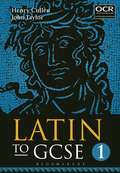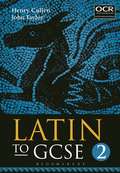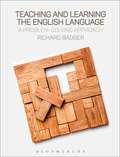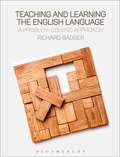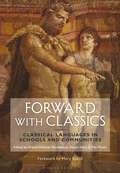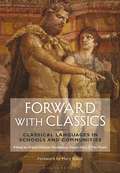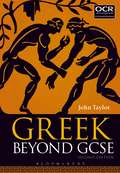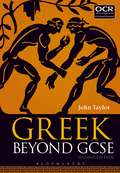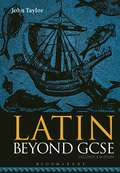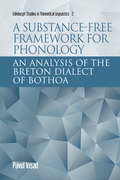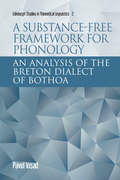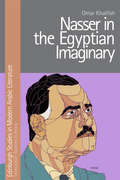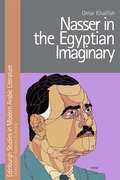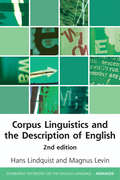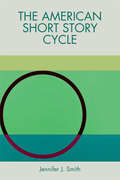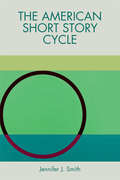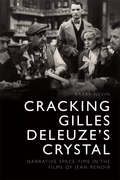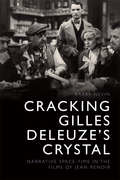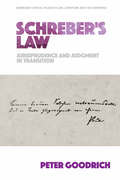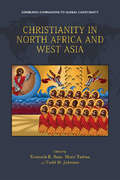- Table View
- List View
Latin to GCSE Part 1
by Henry Cullen John TaylorA companion to Bloomsbury's popular two-volume Greek to GCSE, this is the first course for Latin students that directly reflects the curriculum in a clear, concise and accessible way. Enhanced by colour artwork and text features, the books support the new OCR specification for Latin (first teaching 2016) as well as meeting the needs of later students, both at university and beyond.Written by two experienced school teachers, one also an examiner, the course is based on a keen understanding of what pupils find difficult, concentrating on the essentials and on the explanation of principles in both accidence and syntax: minor irregularities are postponed and subordinated so that the need for rote learning is reduced. User-friendly, it also gives pupils a firm foundation for further study. Part 1 covers the basics and is self-contained, with its own reference section. It outlines the main declensions, a range of active tenses and a vocabulary of 275 Latin words to be learned. Pupil confidence is built up by constant consolidation of the material covered. After the preliminaries, each chapter concentrates on stories with one source or subject: the Fall of Troy, the journeys of Aeneas, the founding of Rome and the early kings, providing an excellent introduction to Roman culture alongside the language study.
Latin to GCSE Part 1
by Henry Cullen John TaylorA companion to Bloomsbury's popular two-volume Greek to GCSE, this is the first course for Latin students that directly reflects the curriculum in a clear, concise and accessible way. Enhanced by colour artwork and text features, the books support the new OCR specification for Latin (first teaching 2016) as well as meeting the needs of later students, both at university and beyond.Written by two experienced school teachers, one also an examiner, the course is based on a keen understanding of what pupils find difficult, concentrating on the essentials and on the explanation of principles in both accidence and syntax: minor irregularities are postponed and subordinated so that the need for rote learning is reduced. User-friendly, it also gives pupils a firm foundation for further study. Part 1 covers the basics and is self-contained, with its own reference section. It outlines the main declensions, a range of active tenses and a vocabulary of 275 Latin words to be learned. Pupil confidence is built up by constant consolidation of the material covered. After the preliminaries, each chapter concentrates on stories with one source or subject: the Fall of Troy, the journeys of Aeneas, the founding of Rome and the early kings, providing an excellent introduction to Roman culture alongside the language study.
Latin to GCSE Part 2
by Henry Cullen John TaylorA companion to Bloomsbury's popular two-volume Greek to GCSE, this is the first course for Latin students that directly reflects the curriculum in a clear, concise and accessible way. Enhanced by colour artwork and text features, the books support the new OCR specification for Latin (first teaching 2016) as well as meeting the needs of later students, both at university and beyond.Written by two experienced school teachers, one also an examiner, the course is based on a keen understanding of what pupils find difficult, concentrating on the essentials and on the explanation of principles in both accidence and syntax: minor irregularities are postponed and subordinated so that the need for rote learning is reduced. User-friendly, it also gives pupils a firm foundation for further study. Part 1 covers the basics, whilst Part 2 introduces a wider range of grammatical forms and constructions, with a vocabulary of 450 words and reading material about the developing Republic, the war with Hannibal, the rise of Julius Caesar, and Augustus and the early emperors. Practice passages and revision sentences for GCSE complete Part 2, which has a reference section covering the whole course.
Latin to GCSE Part 2
by Henry Cullen John TaylorA companion to Bloomsbury's popular two-volume Greek to GCSE, this is the first course for Latin students that directly reflects the curriculum in a clear, concise and accessible way. Enhanced by colour artwork and text features, the books support the new OCR specification for Latin (first teaching 2016) as well as meeting the needs of later students, both at university and beyond.Written by two experienced school teachers, one also an examiner, the course is based on a keen understanding of what pupils find difficult, concentrating on the essentials and on the explanation of principles in both accidence and syntax: minor irregularities are postponed and subordinated so that the need for rote learning is reduced. User-friendly, it also gives pupils a firm foundation for further study. Part 1 covers the basics, whilst Part 2 introduces a wider range of grammatical forms and constructions, with a vocabulary of 450 words and reading material about the developing Republic, the war with Hannibal, the rise of Julius Caesar, and Augustus and the early emperors. Practice passages and revision sentences for GCSE complete Part 2, which has a reference section covering the whole course.
Teaching and Learning the English Language: A Problem-Solving Approach
by Richard BadgerTeaching and Learning the English Language is a practical guide for anyone seeking to improve their teaching, whether through formal study or on their own. Richard Badger explores teaching English as a problem-solving activity in which teachers must address three fundamental questions: · what aspect of language do students need to learn;· how might they learn this particular aspect of language;· and how can teachers support their learning. Offering a solid, research-based approach along with sound practical advice, this book equips teachers with skills needed to analyse their own contexts and develop their practice. It covers:· Fundamentals of English language · Psychological and social learning processes · TESOL teaching methods and approaches· Lesson planning and classroom management· Language evaluation and assessment· Teaching pronunciation, spelling, grammar, vocabulary and discourse· Teaching listening, reading, writing and speaking· English teacher professional developmentPedagogical features include chapter summaries, activities for students and key readings recommendations, and the book is also supported by online resources: video case studies, additional exercises and multiple choice quizzes. Including numerous international lesson examples and case studies, Teaching and Learning English Language is suitable for both trainee and practising teachers who speak English as a first, second or foreign language.
Teaching and Learning the English Language: A Problem-Solving Approach
by Richard BadgerTeaching and Learning the English Language is a practical guide for anyone seeking to improve their teaching, whether through formal study or on their own. Richard Badger explores teaching English as a problem-solving activity in which teachers must address three fundamental questions: · what aspect of language do students need to learn;· how might they learn this particular aspect of language;· and how can teachers support their learning. Offering a solid, research-based approach along with sound practical advice, this book equips teachers with skills needed to analyse their own contexts and develop their practice. It covers:· Fundamentals of English language · Psychological and social learning processes · TESOL teaching methods and approaches· Lesson planning and classroom management· Language evaluation and assessment· Teaching pronunciation, spelling, grammar, vocabulary and discourse· Teaching listening, reading, writing and speaking· English teacher professional developmentPedagogical features include chapter summaries, activities for students and key readings recommendations, and the book is also supported by online resources: video case studies, additional exercises and multiple choice quizzes. Including numerous international lesson examples and case studies, Teaching and Learning English Language is suitable for both trainee and practising teachers who speak English as a first, second or foreign language.
Forward with Classics: Classical Languages in Schools and Communities (Criminal Practice Ser.)
by Arlene Holmes-Henderson Steven Hunt Mai MusiéDespite their removal from England's National Curriculum in 1988, and claims of elitism, Latin and Greek are increasingly re-entering the 'mainstream' educational arena. Since 2012, there have been more students in state-maintained schools in England studying classical subjects than in independent schools, and the number of schools offering Classics continues to rise in the state-maintained sector. The teaching and learning of Latin and Greek is not, however, confined to the classroom: community-based learning for adults and children is facilitated in newly established regional Classics hubs in evenings and at weekends, in universities as part of outreach, and even in parks and in prisons.This book investigates the motivations of teachers and learners behind the rise of Classics in the classroom and in communities, and explores ways in which knowledge of classical languages is considered valuable for diverse learners in the 21st century. The role of classical languages within the English educational policy landscape is examined, as new possibilities exist for introducing Latin and Greek into school curricula. The state of Classics education internationally is also investigated, with case studies presenting the status quo in policy and practice from Australasia, North America, the rest of Europe and worldwide. The priorities for the future of Classics education in these diverse locations are compared and contrasted by the editors, who conjecture what strategies are conducive to success.
Forward with Classics: Classical Languages in Schools and Communities
by Arlene Holmes-Henderson Steven Hunt Mai MusiéDespite their removal from England's National Curriculum in 1988, and claims of elitism, Latin and Greek are increasingly re-entering the 'mainstream' educational arena. Since 2012, there have been more students in state-maintained schools in England studying classical subjects than in independent schools, and the number of schools offering Classics continues to rise in the state-maintained sector. The teaching and learning of Latin and Greek is not, however, confined to the classroom: community-based learning for adults and children is facilitated in newly established regional Classics hubs in evenings and at weekends, in universities as part of outreach, and even in parks and in prisons.This book investigates the motivations of teachers and learners behind the rise of Classics in the classroom and in communities, and explores ways in which knowledge of classical languages is considered valuable for diverse learners in the 21st century. The role of classical languages within the English educational policy landscape is examined, as new possibilities exist for introducing Latin and Greek into school curricula. The state of Classics education internationally is also investigated, with case studies presenting the status quo in policy and practice from Australasia, North America, the rest of Europe and worldwide. The priorities for the future of Classics education in these diverse locations are compared and contrasted by the editors, who conjecture what strategies are conducive to success.
Greek Beyond GCSE
by John TaylorGreek Beyond GCSE covers all the linguistic requirements for the OCR AS and A Level in Classical Greek. It aims to bring students to a point where they can tackle original Greek texts with confidence. Although designed as a continuation of Greek to GCSE, it is self-contained and can be used independently. This second edition is brought in line with the current OCR specifications. The first part of the book introduces new constructions accompanied by exercises including the translation of sentences from English to Greek and reading passages(which in the opening chapters are lightly adapted). The next sections provide translation and comprehension passages at both AS and A Level standard, including verse unseens, scansion, and a list of 300 common poetic words (new to this edition). Next come longer unadapted extracts from a range of authors. Finally there is a reference section including a summary of all constructions, a comprehensive grammar, various appendices and a vocabulary of about 1,200 Greek words.
Greek Beyond GCSE
by John TaylorGreek Beyond GCSE covers all the linguistic requirements for the OCR AS and A Level in Classical Greek. It aims to bring students to a point where they can tackle original Greek texts with confidence. Although designed as a continuation of Greek to GCSE, it is self-contained and can be used independently. This second edition is brought in line with the current OCR specifications. The first part of the book introduces new constructions accompanied by exercises including the translation of sentences from English to Greek and reading passages(which in the opening chapters are lightly adapted). The next sections provide translation and comprehension passages at both AS and A Level standard, including verse unseens, scansion, and a list of 300 common poetic words (new to this edition). Next come longer unadapted extracts from a range of authors. Finally there is a reference section including a summary of all constructions, a comprehensive grammar, various appendices and a vocabulary of about 1,200 Greek words.
Latin Beyond GCSE
by John TaylorLatin Beyond GCSE covers all the linguistic requirements for the OCR AS and A Level in Latin. It aims to bring students to a point where they can tackle original Latin texts with confidence. Although designed as a continuation of Latin to GCSE, it is self-contained and can be used independently. This new edition is brought in line with the new OCR specifications and benefits from a completely redesigned layout, with added colour and images. The answer key is available on a companion website. The first part of the book introduces new constructions and the translation of sentences from English to Latin, with reading passages at AS standard. The next sections provide translation and comprehension passages at AS and A-level, including verse unseens, scansion, and a list of 300 common poetic words. Next come longer unadapted extracts from a range of authors. Finally there is a reference section including a summary of all constructions, a comprehensive grammar, and a general vocabulary of about 1200 Latin words.
Latin Beyond GCSE
by John TaylorLatin Beyond GCSE covers all the linguistic requirements for the OCR AS and A Level in Latin. It aims to bring students to a point where they can tackle original Latin texts with confidence. Although designed as a continuation of Latin to GCSE, it is self-contained and can be used independently. This new edition is brought in line with the new OCR specifications and benefits from a completely redesigned layout, with added colour and images. The answer key is available on a companion website. The first part of the book introduces new constructions and the translation of sentences from English to Latin, with reading passages at AS standard. The next sections provide translation and comprehension passages at AS and A-level, including verse unseens, scansion, and a list of 300 common poetic words. Next come longer unadapted extracts from a range of authors. Finally there is a reference section including a summary of all constructions, a comprehensive grammar, and a general vocabulary of about 1200 Latin words.
A Substance-free Framework for Phonology: agl (Edinburgh Studies in Theoretical Linguistics)
by Pavel IosadWhat is the relationship between phonetics and phonology? Are phonological features innate and universal, and do they have fixed phonetic correlates? These questions have received renewed prominence in theoretical debates, and this book explores them from a modular, substance-free perspective. This in-depth analysis of Breton serves not only to introduce important data from this endangered language into the theoretical landscape but also to demonstrate the viability of a modular phonological framework. The book introduces a minimalist system of phonological representations built up on a language-specific basis, and integrates it with a fully-fledged computational framework, showcasing the numerous empirical and conceptual advantages of a substance-free view of phonology. Presenting the first comprehensive analysis of the sound patterns of a Breton variety treated in a substance-free phonological framework, this book will enhance the understanding of Celtic phonology and offers a valuable reference for postgraduate students, academics and researchers working in phonological theory and Celtic studies.
A Substance-free Framework for Phonology: agl (Edinburgh Studies in Theoretical Linguistics)
by Pavel IosadWhat is the relationship between phonetics and phonology? Are phonological features innate and universal, and do they have fixed phonetic correlates? These questions have received renewed prominence in theoretical debates, and this book explores them from a modular, substance-free perspective. This in-depth analysis of Breton serves not only to introduce important data from this endangered language into the theoretical landscape but also to demonstrate the viability of a modular phonological framework. The book introduces a minimalist system of phonological representations built up on a language-specific basis, and integrates it with a fully-fledged computational framework, showcasing the numerous empirical and conceptual advantages of a substance-free view of phonology. Presenting the first comprehensive analysis of the sound patterns of a Breton variety treated in a substance-free phonological framework, this book will enhance the understanding of Celtic phonology and offers a valuable reference for postgraduate students, academics and researchers working in phonological theory and Celtic studies.
Nasser in the Egyptian Imaginary (Edinburgh Studies in Modern Arabic Literature)
by Omar KhalifahThe late President of Egypt, Gamal Abdel Nasser (1918-1970), has been represented in many major works of Egyptian literature and film, and continues to have a presence in everyday life and discourse in the country. Omar Khalifah’s analysis of these representations focuses on how the historical character of Nasser has emerged in the Egyptian imaginary. He explores the recurrent images of Nasser in literature and film and shows how Nasser constitutes a perfect site for plural interpretations. He argues that Nasser has become a rhetorical device, a figure of speech, a trope that connotes specific images constantly invoked whenever he is mentioned. His study makes a case for literature and art to be seen as alternative archives that question, erase, distort and add to the official history of Nasser.
Nasser in the Egyptian Imaginary (Edinburgh Studies in Modern Arabic Literature)
by Omar KhalifahThe late President of Egypt, Gamal Abdel Nasser (1918-1970), has been represented in many major works of Egyptian literature and film, and continues to have a presence in everyday life and discourse in the country. Omar Khalifah’s analysis of these representations focuses on how the historical character of Nasser has emerged in the Egyptian imaginary. He explores the recurrent images of Nasser in literature and film and shows how Nasser constitutes a perfect site for plural interpretations. He argues that Nasser has become a rhetorical device, a figure of speech, a trope that connotes specific images constantly invoked whenever he is mentioned. His study makes a case for literature and art to be seen as alternative archives that question, erase, distort and add to the official history of Nasser.
Corpus Linguistics and the Description of English
by Hans Lindquist Magnus LevinWartime British writers took to the airwaves to reshape the nation and the Empire
Corpus Linguistics and the Description of English (Edinburgh Textbooks On The English Language - Advanced Ser.)
by Hans Lindquist Magnus LevinExamines the social functions of attitude dative pronouns in four Arabic dialects
The American Short Story Cycle
by Jennifer J. SmithA critical overview of the USA efforts to prevent Iran from building nuclear weapons, from the 1970s to 2015
The American Short Story Cycle
by Jennifer J. SmithExplores the contradictory position of Arabic being both the official language and marginalized in Israel
Cracking Gilles Deleuze's Crystal: Narrative Space-time in the Films of Jean Renoir
by Barry NevinThe first collection of critical essays on the writing of Kathleen Jamie
Cracking Gilles Deleuze's Crystal: Narrative Space-time in the Films of Jean Renoir
by Barry NevinExplores the dynamic relationships between language, politics and society in the Middle East
Schreber’s Law: Jurisprudence and Judgment in Transition
by Peter GoodrichThe first scholarly comparative analysis of Jacques Derrida and Gilles Deleuze's philosophies of difference
Schreber’s Law: Jurisprudence and Judgment in Transition (Edinburgh Critical Studies In Law, Literature And The Humanities Ser.)
by Peter GoodrichHow did Russian writers respond to linguistic debate in the post-Soviet period?
Christianity in North Africa and West Asia
by Kenneth Ross Mariz TadrosAn overview of current corpus-based research on the Arabic language
